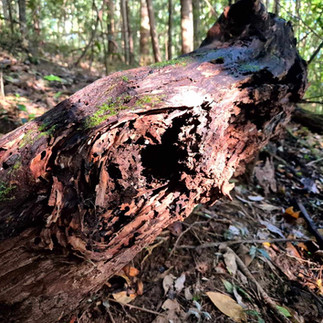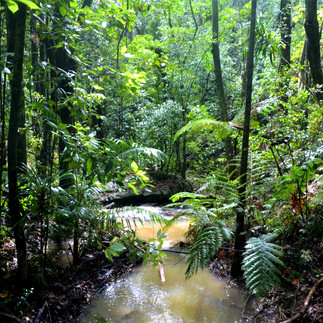Wildlife-friendly Gardens: Incorporating Conservation and Restoration into Landscape Design
- Danny

- Feb 13
- 7 min read
Updated: Mar 6
Every property and landscape design has an opportunity to give and benefit from the native plants, animals and fungi of the land. Native vegetation and wildlife microhabitat are great elements to incorporate into a design and I'm going to show you Why it's important and How to achieve it.
Why Design For Nature?
Air, Water, Food and Sunlight; we share each moment with all that has and is living on Earth. Biology continues to transform raw chemical nonsense into unique expressions of life.
Gardeners just do it with intention.
Intrinsic Value
So firstly, we incorporate bushland and wildlife-friendly gardens into our designs to honor and conserve the unique life that will share this piece of Earth. In Australia, few private landholders are making that choice. In Queensland, 100,000s of hectares of native woody vegetation is cleared each year. Protect what is left and facilitate the restoration of what was, for Nature.
Ecosystem Services
Secondly, Nature provides us gardeners and property owners with a bunch of services:
Pollination
Seed dispersal
Fertlisation
Pest control
Microclimate regulation
Decomposition of outputs
Reconstitution of inputs
Windbreak
Sound and visual break
Flood mitigation
Drought and stress resilience
More Nature means more services, both in scale and diversity of benefits to you, your infrastructure and landscape.
Access Funding
Get access to expert advice, valuable resources and grants to subsidise the learning curve, time and cost of land management. This includes programs such as the Land for Wildlife - South East Queensland and Landholder Environmental Grant on the Sunshine Coast.
Enjoyment
Watching wildlife return, forage and breed in the habitat you've grown, built and let go is an incredibly rewarding feeling. After the initial construction/ planting of habitat, there is often little follow-up maintenance compared to a high-intensity veggie garden or lawn. You simply become a passive observer as nature quickly interacts and adapts to this new resource you've cultivated.
How to Design a Wildlife-friendly Garden and Achieve Conservation and Restoration Outcomes
How can we protect, enhance or restore ecological values throughout the landscape?
Enhance and Restore
Consider both, what are the existing and pre-existing ecological values on your property? Typically, this includes waterways and native bushland.
Waterways: whether it's seasonal or permanent, there are key indicators to assess the health of a waterway:
Extent and condition of riparian vegetation. Riparian vegetation should extend from the water bank toe to well beyond the top of the bank (minimum of 1.5 x the width of the watercourse beyond the bank).
Erosion of the water banks and in-stream beds. Waterway erosion compromises the stability of the watercourse and can get out of control quickly resulting in the loss of habitat, loss of useable land, excessive tree falling and leave infrastructure and surrounding landscape elements vulnerable to high rain events.
Bushland: Assessing the health of bushland is easily done by considering the composition, structure and habitat features within it.
Determine what are the dominant species throughout the canopy, subcanopy and understorey layers. This provides insight into the expected structure of the vegetation when it's in a mature state and the associated microhabitat provisions to fauna, flora and fungi. Then a high-quality 'reference ecosystem' can be used to compare against the on-ground current condition and determine the opportunity for improvement. Some will be obvious such as canopy cover in the overstorey or wood debris throughout the forest floor whilst others such as the potential to introduce threatened or rare species will be less obvious and may require some research.
Some 'low-hanging fruit' to enhance waterways and bushland include:
Targeting threatened species: Planting threatened flora species or targeting plants that provide habitat features necessary for a threatened animal
Breeding features:
Tree hollows or supplementary nest boxes: arboreal mammals
Water features such as ephemeral ponds, dams and drainage lines: frogs, fish and reptiles
Logs, coarse wood debris and rock piles: reptiles
Nectar-rich flowering shrubs and trees: grevillea, banksia, leptospermums and the like provide an abundance of food sources for parrots and honeyeaters
Specialised foraging trees: Lots of Australian animals depend on the presence of specific plant species such as black cockatoos and she-oaks (Casuarina spp.).
Waterway and riparian veg: Waterways provide refuge during seasonal extremes, ecological corridors throughout the landscape, complex and abundant microhabitat features
Ecological corridors and connectivity: Prioritise restoration areas adjacent to existing habitat to maximise patch size and connectivity.
Left to right: Hollow log, rocks and woody debris, waterway and riparian vegetation
Designing for Conservation
There is plenty of room for conservation and restoration in a landscape design. You can squeeze frog ponds, flowering native shrubs and trees throughout your home veggie garden, along pathways, borders and generally scattered throughout Zone 1.
However, it is the outer Zones which offer the greatest potential to enhance and restore habitat.
Habitat patches:
These are small to medium areas (usually 5-50m2), that are intentionally designed and maintained to produce habitat. Habitat patches can border a shed, retain a bank, fill in a seasonal drainage line and really anywhere you can think of. Once planted/ constructed, habitat patches are low maintenance so they're perfect to decrease the maintenance demand of your landscape whilst providing interesting features that attract pollinators, predators and the rest. I recommend including habitat patches around rest spots, entertainment areas and garden benches as you'll be surprised and ever-intrigued with how wildlife interacts and adapts to the new habitat.
Wind/ Sound/ Visual break
Most of us want privacy from our neighbours and street. This provides a great opportunity to grow a 'living fence'. Most of the time, I'd be opting for an edible living fence within my Zone 1 and Zone 2 as the opportunity to grow passionfruit, kiwi fruit, or grapes is too good to pass. However, it's likely you may have boundaries and use for a living fence throughout outer zones. Here is a great opportunity to incorporate native vegetation and habitat.
Drainage Lines and Greywater Outlets
How does the water drain from your landscape? Can we incorporate creek beds, ponds and clumps of aquatic plants that'll provide habitat to native frogs and mosquito-feeding dragonflies. Moreover, where is your grey water outlet draining to? Replace a small patch of lawn with aquatic habitat. Consideration should be made to prevent and mitigate cane toads from entering and outcompeting native frogs within aquatic habitat. Elevate your pond or densely plant a border of lomandras, other thick shrubs or rocks to prevent them from entering.
Timber Piles & Habitat Stacks
If you've already got native bushland on your property, you'll inevitably have access to small to large branches and tree trunks that have dropped and fallen through the cycle of the forest. Utilising these resources along with woody debris you may heavily pruned or removed from other areas can provide the materials to build habitat stacks and timber piles that are quickly used by reptiles, small birds and rodents. Sooner or later the soil life get in there and a simple intervention is suddenly a party for native wildlife. Similarly, rock piles can also provide habitat and can be mixed with wood or piled on their own. Any cavity you can make will be extra useful and likely utilised as breeding habitat. Situate close to a seasonal or permanent water source and you'll maximise the benefits.
Siliviculture & Agroforestry
If your site is large enough, it's a great idea to designate an area in the outer zones to the cultivation of large to medium trees and produce timber, nuts, fruit and of course, wildlife habitat.
Typically, an 'Agroforestry' element will be centred around the cultivation of large (20m+) trees that will be selectively harvested long in the future for timber. Naturally, this element tends to be large in size (0.5 acre+) and low maintenance with essential visits few and far between.
We would ecologically categorise an 'Agroforestry' element as an Open Forest with 30-70% canopy cover and 10-30m tall. Therefore, this habitat is suitable for a range of wildlife including macropods, arboreal and terrestrial mammals, reptiles and lots of birdlife. An agroforestry element is perfectly suited for habitat enhancement and the aforementioned habitat stacks, artificial hollows and aquatic habitat will further transform the site into a wildlife-friendly garden.
Monitoring
Whilst it's fair to assume wildlife will adapt and make use of any newly created habitat, its always good practice to monitor and observe any intervention to determine success and opportunities for improvement. Whilst you can deduce and takeaway a lot from frequently visiting and walking around the new habitat features, taking an extra formalised step will give you more specific, comparable data. There are plenty cost-effective and passive techniques including:
Photopoint monitoring
Spotlighting at night
Vantage point - usually best at dawn and dusk
Scat searches
Camera traps - bait and leave for 7 nights
Active searches for nests and other breeding features
Monitoring habitat and watching which fauna groups and specific species are foraging, breeding and sheltering in the newly created resource will give insight to wildlife behaviour and how they disperse seeds, reproduce and interact with your designed ecosystem.
Conclusion
Incorporating conservation and ecological restoration into landscape design isn’t just about sustainability—it’s about creating a living, thriving system that benefits both people and nature. By integrating habitat patches, water features, native vegetation, and thoughtful land management practices, we can foster biodiversity, improve ecosystem services, and build resilience against environmental stressors.
Every property, no matter the size, holds the potential to contribute to conservation efforts. Whether it’s a small backyard, a working farm, or a large rural property; intentional design choices can restore ecological balance while enhancing the beauty and function of the space. Over time, as wildlife returns and ecosystems re-establish themselves, the rewards extend beyond the landscape itself—creating a deeper connection to nature and a lasting legacy of regeneration.
Start small, observe, and let nature take the lead. With time and thoughtful intervention, your landscape can become not just a space you cultivate, but a habitat you share.
If you're ready to create a thriving, ecologically rich landscape, Holhab’s landscape design services can help bring your vision to life. Contact us today and let's start!

























Comments